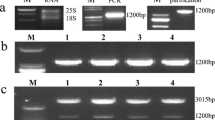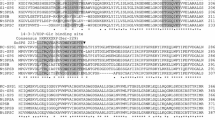Abstract
Phytochrome A (phyA), as a photoreceptor, has a profound influence on plant growth and development and participates in many important physiological processes, such as seed germination, seeding deetiolation, and flowering. On the basis of transcriptome database of sweet potato (Ipomoea batatas (L.) Lam.), phyA gene was cloned and sequenced. The gene has an open reading frame (ORF) of 3384 bp, encodes a protein with 1127 amino acid residues and a mol wt of 125.03 kD. More interestingly, it was found that there were three highly homologous phyA cDNA isoforms in sweet potato. In addition, when the genomic sequence of phyA gene was obtained by PCR using sweet potato genomic DNA as a template, it contained 4 exons and 3 introns with a total size of 4957 bp. The cDNA of phyA gene was inserted into the vector pET-32a(+) and successfully expressed in Escherichia coli BL21(DE3). The results of quantitative real-time PCR indicated that the expression level of phyA gene was higher in stem, followed by leaf, and the lowest in tuberous root. Besides, the expression of phyA mRNA in the mature leaf showed an obvious circadian rhythm in a day: mRNA accumulation gradually increased in darkness and decreased in the daylight.
Similar content being viewed by others
Abbreviations
- FRL:
-
far-red light
- HIR:
-
high irradiance response
- phyA:
-
phytochrome A
- RL:
-
red light
- VLFR:
-
very low fluence response
References
Li, S.Z. and Chan-Halbrendt, C., Ethanol production in (the) People’s Republic of China: Potential and technologies, Appl. Energy, 2009, vol. 86, pp. S162–S169.
Deng, X.W. and Quail, P.H., Signalling in light-controlled development, Semin. Cell Dev. Biol., 1999, vol. 10, pp. 121–129.
Franklin, K.A. and Quail, P.H., Phytochrome functions in Arabidopsis development, J. Exp. Bot., 2010, vol. 61, pp. 11–24.
Sharrock, R.A. and Quail, P.H., Novel phytochrome sequences in Arabidopsis thaliana: structure, evolution, and differential expression of a plant regulatory photoreceptor family, Genes Dev., 1989, vol. 3, pp. 1745–1757.
Dehesh, K., Tepperman, J., Christensen, A.H., and Qual, P.H., phyb is evolutionarily conserved and constitutively expressed in rice seedling shoots, Mol. Gen. Genet., 1991, vol. 225, pp. 305–313.
Tahir, M., Kanegae, H., and Takano, M., Phytochrome C (PHYC) gene in rice: isolation and characterization of a complete coding sequence, Plant Physiol., 1998, vol. 118, p. 1535.
Montgomery, B.L. and Lagarias, J.C., Phytochrome ancestry: sensors of bilins and light, Trends Plant Sci., 2002, vol. 7, pp. 357–366.
Pratt, L.H., Cordonnier-Pratt, M.M., Hauser, B., and Caboche, M., Tomato contains two differentially expressed genes encoding B-type phytochromes, neither of which can be considered an ortholog of Arabidopsis phytochrome B, Planta, 1995, vol. 197, pp. 203–206.
Rockwell, N.C. and Lagarias, J.C., The structure of phytochrome: a picture is worth a thousand spectra, Plant Cell Online, 2006, vol. 18, pp. 4–14.
Nagatani, A., Phytochrome: structural basis for its functions, Curr. Opin. Plant Biol., 2010, vol. 13, pp. 565–570.
Rockwell, N.C., Su, Y.S., and Lagarias, J.C., Phytochome structure and signaling mechanisms, Annu. Rev. Plant Biol., 2006, vol. 57, pp. 837–858.
Chen, M., Chory, J., and Fankhauser, C., Light signal transduction in higher plants, Ann. Rev. Genet., 2004, vol. 38, pp. 87–117.
Quail, P.H., Phytochrome photosensory signalling networks, Nat. Rev. Mol. Cell Biol., 2002, vol. 3, pp. 85–93.
Kim, L., Kircher, S., Tóth, R., Adam, E., Schäfer, E., and Nagy, F., Light-induced nuclear import of phytochrome-A:GFP fusion proteins is differentially regulated in transgenic tobacco and Arabidopsis, Plant J., 2001, vol. 22, pp. 125–133.
Tamura, K., Peterson, D., Peterson, N., Stecher, G., Nei, M., and Kumar, S., MEGA5: molecular evolutionary genetics analysis using maximum likelihood, evolutionary distance, and maximum parsimony methods, Mol. Biol. Evol., 2011, vol. 28, pp. 2731–2739.
Schwede, T., Kopp, J., Guex, N., and Peitsh, M.C., SWISS-MODEL: an automated protein homologymodeling server, Nucleic Acids Res., 2003, vol. 31, pp. 3381–3385.
Borthwick, H.A., Hendricks, S.B., Parker, M.W., Toole, E.H., and Toole, V.K., A reversible photoreaction controlling seed germination, Proc. Natl. Acad. Sci. USA, 1952, vol. 38, pp. 662–666.
Casal, J.J. and Sánchez, R.A., Phytochromes and seed germination, Seed Sci. Res., 1998, vol. 8, pp. 317–330.
Sharma, R., Phytochrome: A serine kinase illuminates the nucleus! Curr. Sci. (Bangalore), 2001, vol. 80, pp. 178–188.
Christie, J.M. and Jenkins, G.I., Distinct UV-B and UV-A/blue light signal transduction pathways induce chalcone synthase gene expression in Arabidopsis cells, Plant Cell Online, 1996, vol. 8, pp. 1555–1567.
Shinomura, T., Nagatani, A., Chory, J., and Furuya, M., The induction of seed germination in Arabidopsis thaliana is regulated principally by phytochrome B and secondarily by phytochrome A, Plant Physiol., 1994, vol. 104, pp. 363–371.
Whitelam, G.C., Johnson, E., Peng, J., Carol, P., Anderson, M.L., Cowl, J.S., and Harberd, N.P., Phytochrome A null mutants of Arabidopsis display a wildtype phenotype in white light, Plant Cell Online, 1993, vol. 5, pp. 757–768.
Somers, D.E., Devlin, P.F., and Kay, S.A., Phytochromes and cryptochromes in the entrainment of the Arabidopsis circadian clock, Science, 1998, vol. 282, pp. 1488–1490.
Johnson, E., Bradley, M., Harberd, N.P., and Whitelam, G.C., Photoresponses of light-grown phyA mutants of Arabidopsis (phytochrome A is required for the perception of daylength extensions), Plant Physiol., 1994, vol. 105, pp. 141–149.
Reed, J.W., Nagatani, A., Elich, T.D., Fagan, M., and Chory, J., Phytochrome A and phytochrome B have overlapping but distinct functions in Arabidopsis development, Plant Physiol., 1994, vol. 104, pp. 1139–1149.
Gao, M., Ashu, G.M., Stewart, L., Akwe, W.A., Njiti, V., and Barnes, S., Wx intron variations support an allohexaploid origin of the sweetpotato [Ipomoea batatas (L.) Lam.], Euphytica, 2011, vol. 177, pp. 111–133.
Tao, X., Gu, Y.H., Wang, H.Y., Zheng, W., Li, X., Zhao, C.W., and Zhang, Y.Z., Digital gene expression analysis based on integrated de novo transcriptome assembly of sweet potato [Ipomoea batatas (L.) Lam.], Plos One, 2012, vol. 7: e6234.
Hall, A., Kozma-Bognár, L., and Tóth, R., Conditional circadian regulation of PHYTOCHROME A gene expression, Plant Physiol., 2001, vol. 127, pp. 1808–1818.
Lakin-Thomas, P.L., Circadian rhythms: new functions for old clock genes, Trends Genet., 2000, vol. 16, pp. 135–142.
McWatters, H.G., Bastow, R.M., Hall, A., and Millar, A.J., The ELF3 zeitnehmer regulates light signalling to the circadian clock, Nature, 2000, vol. 408, pp. 716–720.
Author information
Authors and Affiliations
Corresponding author
Additional information
This text was submitted by the authors in English.
Rights and permissions
About this article
Cite this article
Wang, J.X., Jiang, Y.S., Yan, Y. et al. Cloning, expression, and characterization of phyA gene from Ipomoea batatas . Russ J Plant Physiol 62, 109–115 (2015). https://doi.org/10.1134/S102144371406020X
Received:
Published:
Issue Date:
DOI: https://doi.org/10.1134/S102144371406020X




